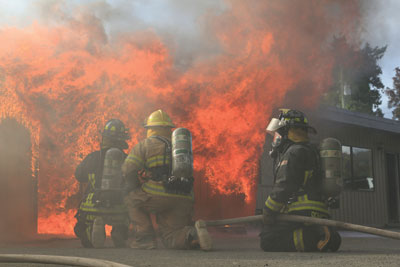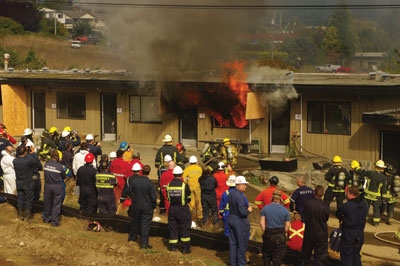
Features
Hot topics
Incident reports
Live fire
When Steve Sorensen took a level 2 fire investigation course in 1999, all of the analyzing, scrutinizing and theorizing were done among specially built drywall and plywood cubicles – a rather clinical, not-too-realistic setting.
April 1, 2011
By Shannon Moneo
When Steve Sorensen took a level 2 fire investigation course in 1999, all of the analyzing, scrutinizing and theorizing were done among specially built drywall and plywood cubicles – a rather clinical, not-too-realistic setting.
 |
|
| Firefighters in Sooke, B.C., gained valuable live-fire experience during a training exercise at a hotel that was set for demolition. Photo courtesy Sooke Fire Rescue |
“I thought, ‘Wouldn’t it be nice if they had an actual building for this?’ ” recalls Sorensen, who has been chief of Sooke Fire Rescue for two years.
A longtime Sooke resident who joined the volunteer department in 1980, Sorensen was familiar with most of the buildings in the 12,000-person community, about 40 kilometres west of Victoria. One structure – perfect for a training exercise – had caught his eye several years ago. It was a 20-room motel that had changed names three times over. Each time the former Manuel Quimper Motel had a new owner, Sorensen would make his way to the waterfront lodgings and ask the innkeeper what the plans were for the slightly seedy motel. Finally, in 2009, when developer Mike Barrie bought the property with plans for a new resort and condo complex, Sorensen got his wish. The structure could be used for a comprehensive fire investigation training exercise. “Barrie thought it was a great idea,” Sorensen says.
Not only was the building available, it was perfect for the training exercise due to its construction, says Sorensen, also a journeyman carpenter since 1984. The one-storey motel had a wood ceiling, no attic, wood floors, cement block walls and was asbestos-free.
Sorensen, who is also in charge of Sooke’s five paid and 45 volunteer firefighters, knew he’d need help to recreate different scenarios and organize such a comprehensive event. Shortly after Barrie gave the green light, Sorensen approached the Fire Prevention Officers Association of British Columbia (FPOABC).
Robert Marshall, inspector at View Royal Fire Rescue (a Victoria suburb) and FPOABC vice-president, realized Sorensen’s ambitious vision would be a great training opportunity but one that needed even further expertise. Eager to take advantage of a partnering opportunity with an organization accustomed to high-end fire investigations, Marshall asked the B.C. chapter of the International Association of Arson Investigators (IAAI) to participate.
The IAAI wholeheartedly agreed to do most of the training and organize the burns, with 12 of its 18 B.C. board members playing direct roles, says B.C. IAAI president Terry Zweng. The FPOABC held a supporting role, carrying the administrative load and making sure all was ready for the 100 registrants and guest speakers from across British Columbia and parts of Alberta who travelled to Sooke for the Sept. 21-24 training exercise.
It’s not often the FPOABC and IAAI work together, as both have carved out their specialties. In fact, Marshall suspects the exercise was one of the first co-organized events in British Columbia. “The FPOABC have been involved in projects like this, but on our own. This was an opportunity to bridge the gap and work with the IAAI,” he says. “It went excellent.”
Work began in January 2010 when Vancouver-based Zweng did a site visit. Sorensen originally wanted to strike the matches in April, but the motel with a death sentence stayed open for the summer season.
As planning progressed, speakers were secured, including police experts in clandestine labs and investigations, an expert on juvenile fire setters and specialists in arc mapping, fire modelling and fatality management.
To start, the motel had to be prepped and burned. Over two days, 10 motel rooms were set up with different scenarios and then lit. “We had a good old time burning it up,” says Zweng, who has investigated more than 1,000 fires over almost 20 years.
After one day spent in the classroom listening to speakers, the 100 participants were split into 10 groups of 10, with two to three leaders in each group. Each group included fire, police and insurance personnel.
A host provided basic information at each of the 10 fire scenes. Each group was allowed to spend 15 minutes in each room, where their task was to figure out the cause and origin of the fire. Some of the scenarios included the recreation of a homicide with bullet casings on the floor, an electrical fire, a deliberately set fire, an accidental fire and one legendary scenario – gas in a cup that was swinging over a candle, which eventually ignited, as planned, one hour later.
“It was very eye-opening,” said Cam Norris-Jones, a Sooke Fire Rescue volunteer for three years who became one of the department’s paid staff in June. “We saw that what we do on fire suppression influences the success of a fire investigation. If you walk into a room and move something, you have to remember where it was.”
One of the scenarios proved to be a particular challenge, Norris-Jones said.
It involved a coffee pot on a stove, with a wastepaper basket beside the stove. Most would assume the fire started on the stove but it was an electrical fire, started in the kitchen fan’s exhaust system, then spreading to the stove and down.
“A lot of people don’t look up. They focus on looking down,” Zweng says. “You want to make sure you look at all possible ignition sources.” A good fire investigator, he says, is highly curious, thinks outside the box, doesn’t accept the obvious and has an open mind.
Norris-Jones added “patience” to Zweng’s list. “It’s a painstaking process. You have to go through a pile of rubble. A lot of stuff can be missed,” he said.
Once the 15 minutes expired, one group member filled out a form and, based on their answers and observations, each group tried to determine the fire cause.
 |
|
| A one-storey motel in Sooke, B.C. with a wood ceiling, no attic, wood floors and cement-block walls was perfect for a training exercise that involved 100 participants and 10 live-fire scenarios. Photo courtesy Sooke Fire Department
|
Valuable data was also gathered at the burns. Each of the 10 rooms was outfitted with camera and heat detection equipment and all of the hardware was connected to computers. Students from the University of British Columbia spent one day monitoring the burn patterns in each room using infrared detection equipment. And a B.C.-based sheeting company installed fire-resistant sheeting panels for testing purposes. “They worked remarkably well,” Sorensen notes.
Some of the monitored results involved infrared detection and may bring changes to British Columbia’s fire code, he added.
Another interesting experiment involved sprinkler systems used in two rooms that were not part of the fire cause exercise. One room had sprinklers; a second did not. In both rooms, the fire started in the bathroom. The room without a sprinkler system was allowed to burn for five minutes. During that short time, the room was destroyed. In the room with the sprinklers, the fire was extinguished within 15 seconds.
Damage was minimal, a concept that the fire department continues to stress to B.C.’s residential builders and developers who most often don’t want to build homes with the added cost of sprinkler systems, Sorensen said.
A professional photographer filmed the events and will produce a training video with the footage that will be available to fire departments.
The following day, participants did classroom work and, on the final day, a panel of experts (building inspector, electrical expert, sprinkler fitter, fire commissioner) took questions. The session was followed by a one-hour exam.
“A lot of different things came out of it that we didn’t count on when we first got going,” Sorensen says, including the useful practice the Sooke Department got when it had to put out 20 fires.
Because fire, police and insurance personnel were present, the exercise was a rare opportunity to network. RCMP and municipal force members swapped stories and professional and volunteer firefighters, not known for their affinity, worked side by side.
Marshall, who has worked in the fire service for 11 years, was interested in hearing from the insurance side and finding out the difficulties insurance investigators face. Once the fire investigators rake through a fire scene, they’ve pretty well destroyed it, leaving insurance inspectors with a formidable sleuthing task, Marshall says. Often, something as simple as kicking a chair out of the way can diminish the evidence.
The $350-per-student registration fee covered all costs for the four-day exercise, Sorensen says.
Registrants came from all over British Columbia, from as far north as Fort St. John. Calgary and Edmonton sent insurance professionals. There were a few chuckle-worthy moments; for example, when an RCMP officer tried to lob a Molotov cocktail into one of the motel rooms. Not terrorist material, it took him almost 15 minutes to get ignition.
Everyone agreed that the exercise provided a valuable learning opportunity that should be replicated. Zweng hinted that the FPOABC is planning a similar exercise for May in Langley, B.C.
“It’s a great way to throw ideas around and learn from each other,” Zweng says.
Print this page